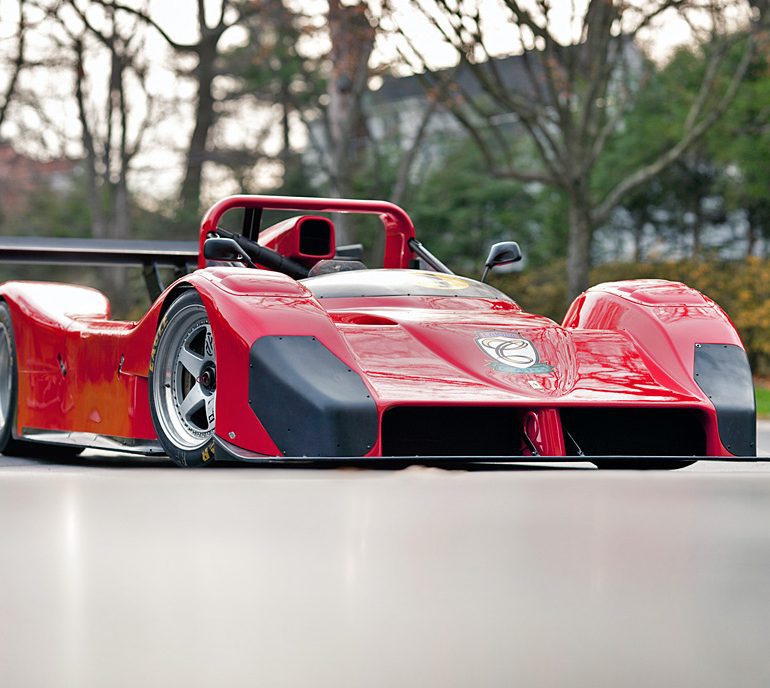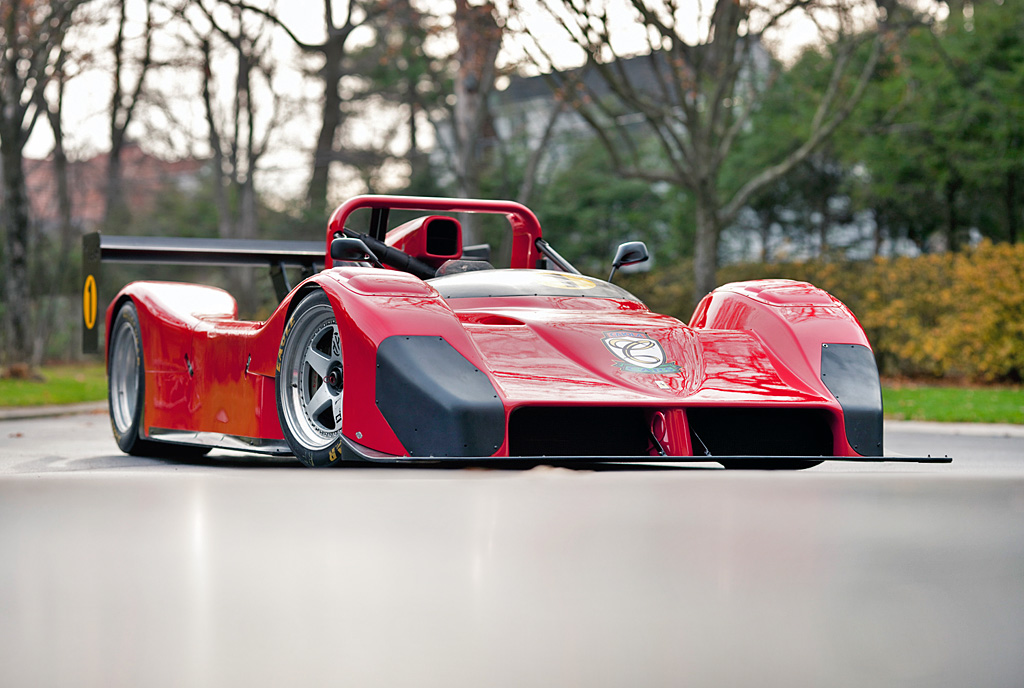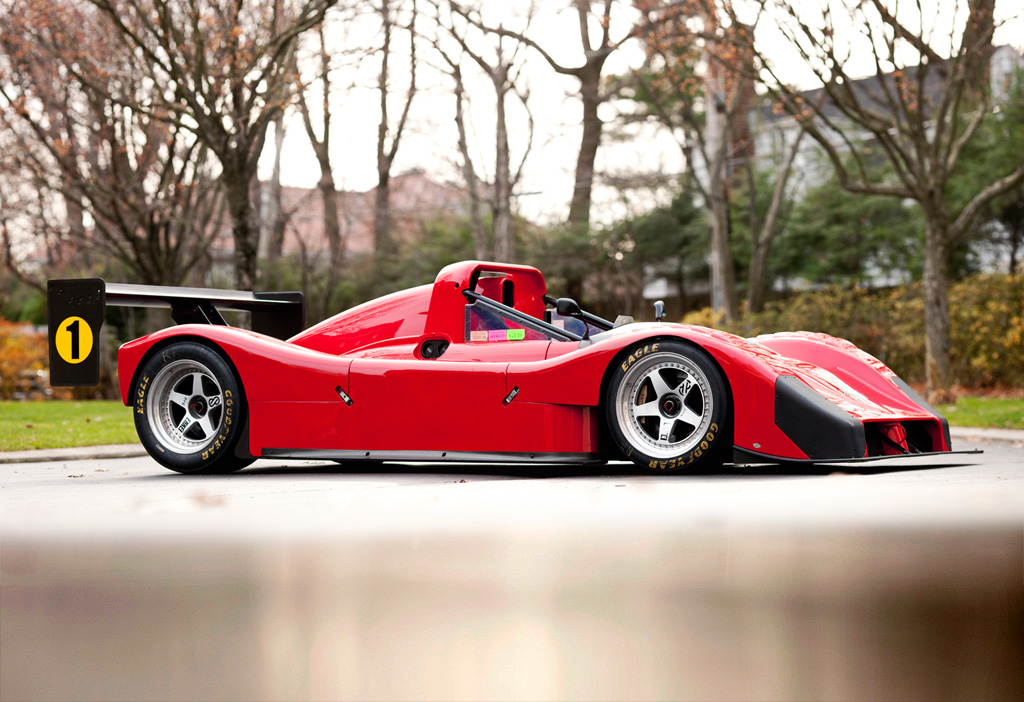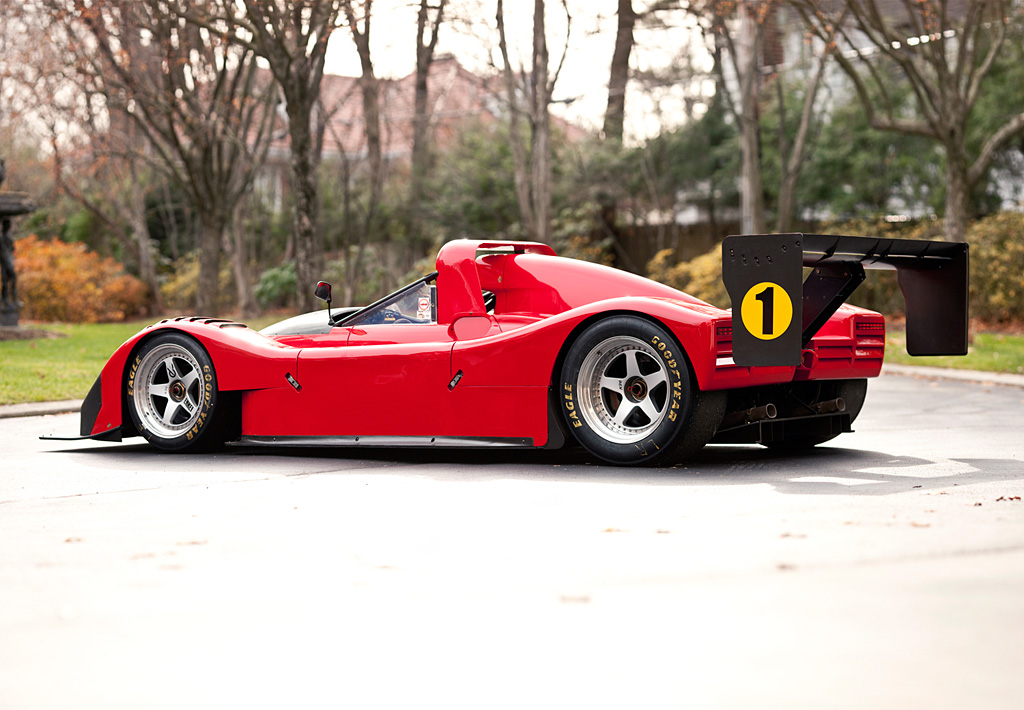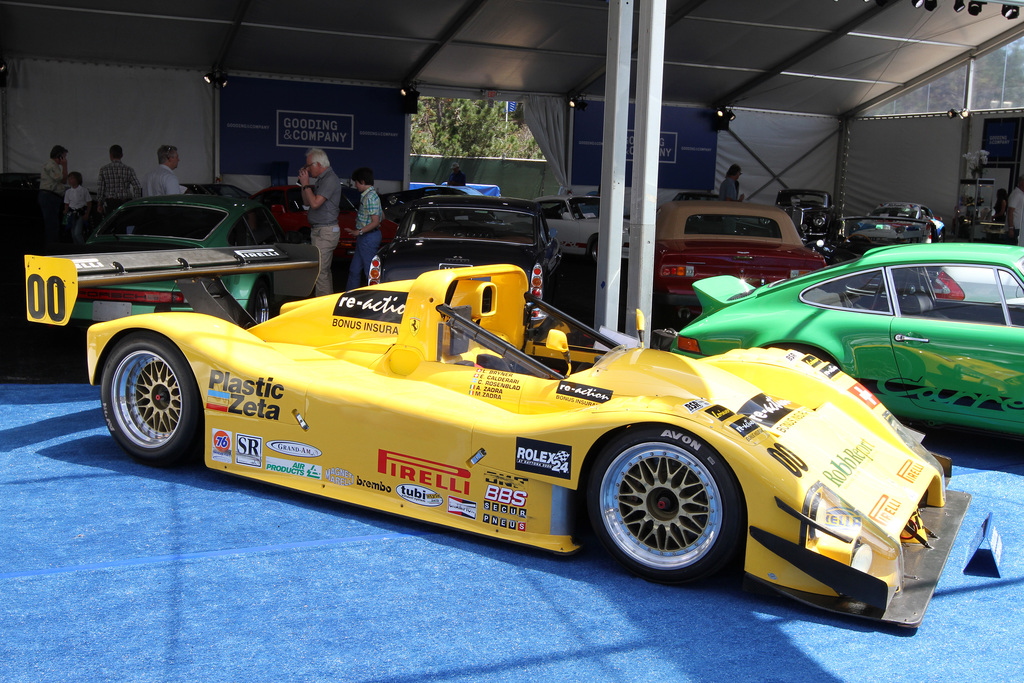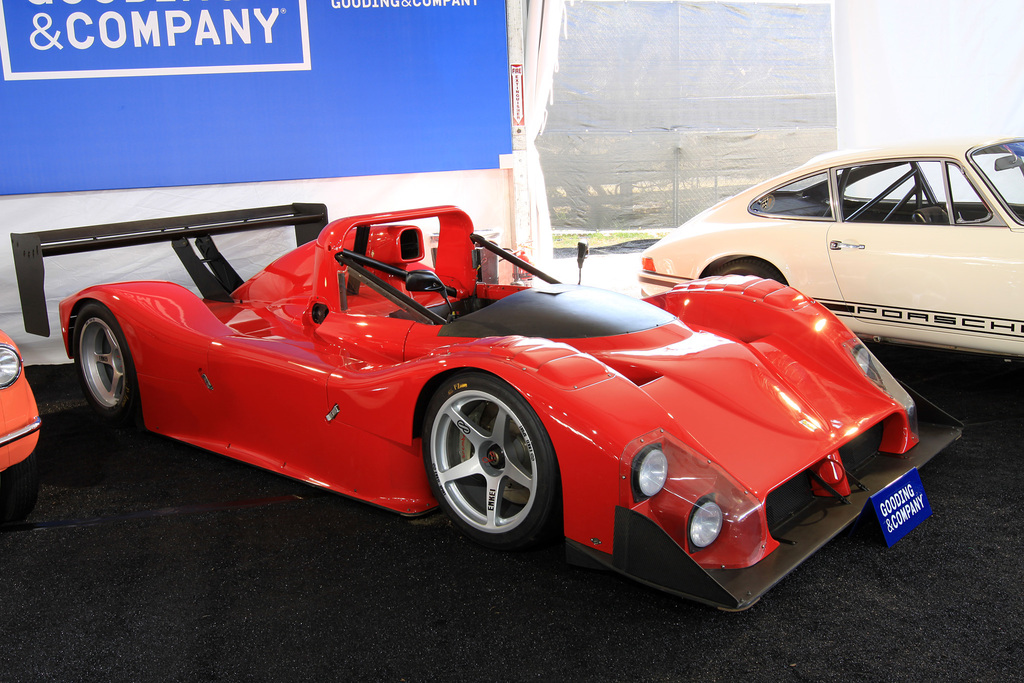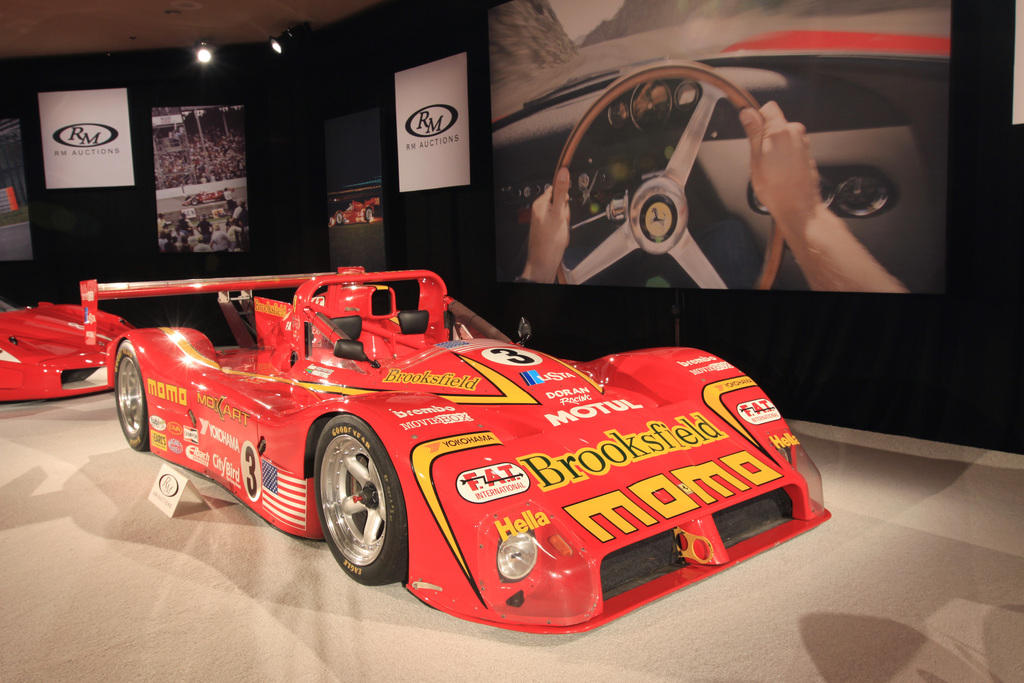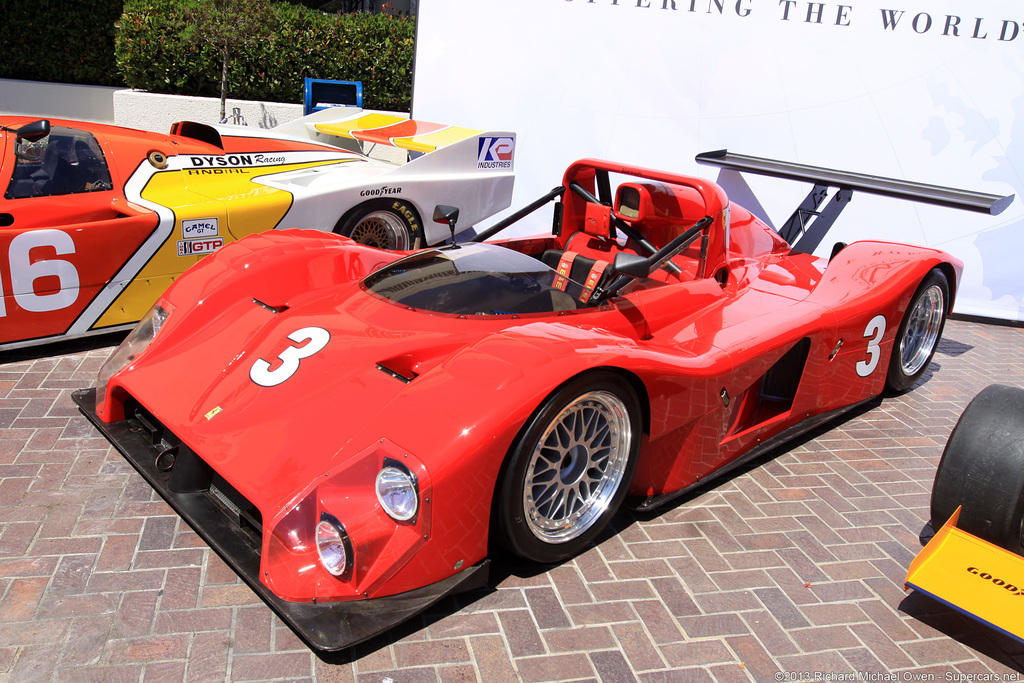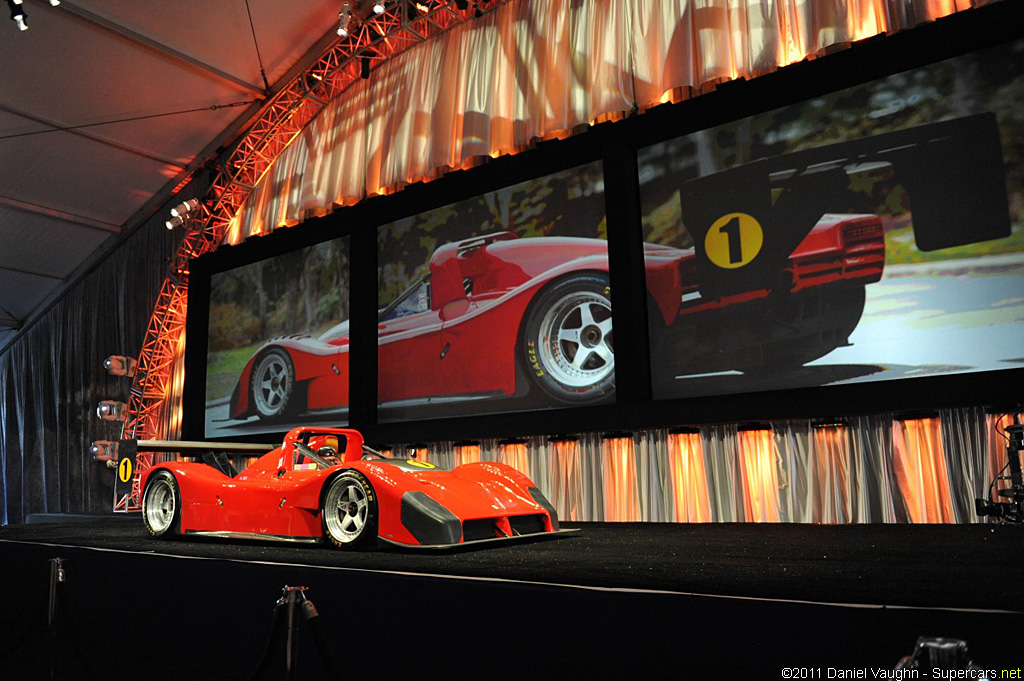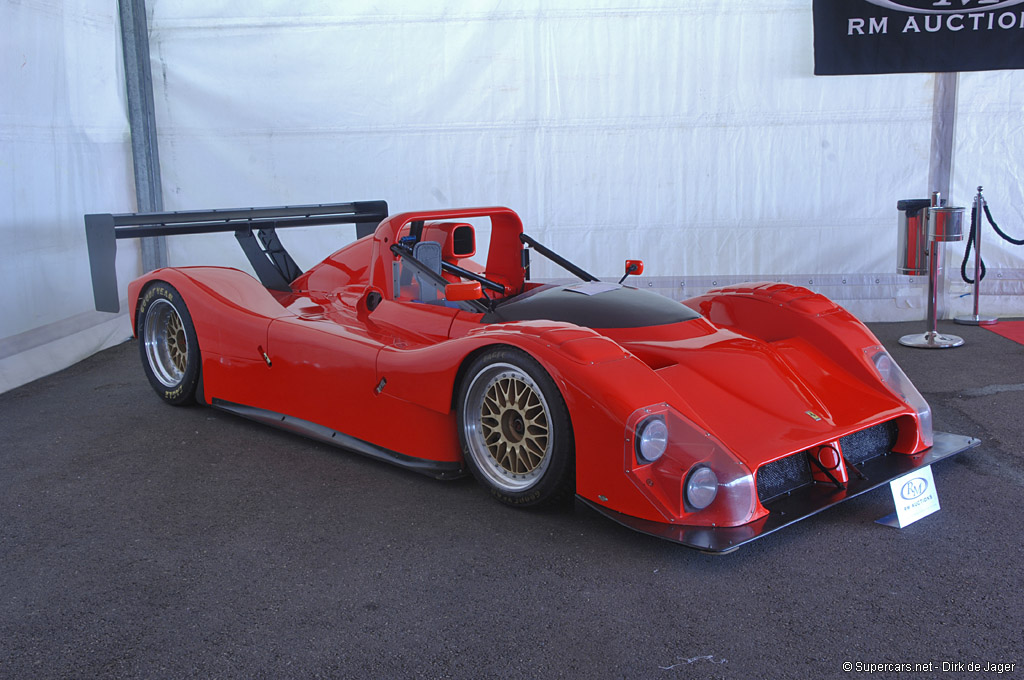Ferrari F333 SP
After a 20 year absence from sports prototype racing, Ferrari revealed the F333 SP as part of their successful return. Built initially to run IMSA’s Exxon World Sports Car Championship in 1994, many called it an F1 car with two seats and full bodywork. Intended for private teams, the F333 was also quite successful—it won 12 Hours of Sebring, 24 Hours of Daytona and many championships in the period between 1998 to 2001.
Derek Bell, who has driven Ferrari’s sports prototypes from both eras says the F333 “drives like a wide bodied F1 car and is totally complete, flawless and homogeneous.”4
The F333 was constructed using techniques from Ferrari’s own F92 Formula 1 car, but was designed and manufactured partially at the facilities of Dallara in Parma and later with Michelotto Automobili in Padova. Chief Designer Mauro Rioli and aerodynamicists Dialma Zinelli and Giorgio Camaschella designed the car as a widened F1 with a fully-enclosed, two-seat body.5 WSC regulations meant that the car had to be an open-top, flat-bottomed design with no ground-effect venturis and be powered by a 4.0-liter, unblown engine sourced from a production car.
Fortunately, Ferrari had the F50, also known as project F130, coming down the pipeline so the engine was sourced from it. This unit was inspired by the 3.5-liter F1 engine and reduced from 4.7 to 4.0-liters which gave a single cylinder displacement of 333 cc. 650 bhp was possible when the car wasn’t running with restrictors that were imposed on the teams in later years. Unique to the design was a 5-valve cylinder head which could freely rev above 10,000 rpm and created a distinctive sound described by the teams as the “l’arrabiata” or enraged one.4
Chassis construction of the F333 is made from carbon-fiber composite and aluminum honeycomb covered by a carbon-fiber/nomex body. The panels are all quickly removable to reveal the fully-stressed V12 engine and sequential-manual gearbox which are an integral part of the chassis. The driver is quite well protected by a substantial roll hoop and additional bracing. Inside, the cockpit purposely sparse except for a few essentials such as toggles, fuses and the digital dashboard.
Racing
Since this was the first prototype from Ferrari since the 312 P of 1971, it won many prestigious events outright that hadn’t had a Ferrari victory in over 20 years.
The first F333 appeared at to prospective owners before the 1994 season by MOMO owner and sometimes driver Giampiero Moretti. During that season four cars were sent to America to compete in the IMSA GT Championship and they debuted mid-season in the Atlanta Sprint at Road Atlanta to win a resounding victory first time out. They won four races that year, but lost the overall Championship to the Oldsmobile Cutlass Supremes by four points.
In 1995, the design was updated to a new longer nose and each car had different aerodynamic details depending on the downforce required. Scandia Motorsports put their car to good use and won the 1995 12 Hours of Sebring outright. Another car would repeat this feat in 1997 and 1998, but the overall victory at Le Mans eluded the Ferrari. Another historic victory came at the 1998 24 Hours of Daytona when the F333 SP’s 1-2-3 victory was reminiscent of Ferrari’s own 1-2-3 in 1967.
Michelotto’s Series II
Driver Didier Theys said the F333’s “potential, if it were a Factory entry, would be far greater since none of the teams had the means to truly develop it extensively.” He talked about the development: “For 1996 at Momo we developed closed flanks bodywork. This and other versions were studied by Michelotto before they produced their 1998 body. For Le Mans and the European ISRS series the rules have allowed a six speed gearbox as well as one inch bigger wheels.”4
Kevin Doran, who managed the Momo team with Didier said “There has been very little development to the car in all these years because it has been very good from the beginning. The new nose developed for 1995 was, I think, primarily for aesthetics!” He also says the only major revision to the car was the 1998 engine which was much more durable thanks to its smaller valves and modified air filter.4
From car number 017 forward, the 1998 cars received the small-valve engine, a strengthened chassis and four-pages of numerous detail changes engineered by Ferrari themselves. These won Sebring and Daytona outright with a class victory at Le Mans. With even more updates, the F333 was successfully raced up to 2001 and won the FIA Sportscar Championship and IMSA GT Championship several times. In 2000, the Doran racing team fitted Judd GV4 V10 in an attempt to keep the old chassis competitive.
In total around 40 cars were manufactured in two series. The first 14 were constructed by Dallara while the remaining cars came from Michelotto. Ferrari priced the car at $900,000 USD which included two extra engines and a cache of spare parts.1
Our feature example is chassis 028 which was sold new to Benny Caiola 1999. Manufactured in 1999 by Michelotto, it was only used sparingly as a track-day toy and was preserved in outstanding and original condition. It will be offered by Gooding & Company at their upcoming 2011 Scottsdale Auction.
Sources & Further Reading
1.McDermott, Jerry. ‘The Ferrari 333 SP’ Cavallino 79. February/March 1994.
2.Barnes, John. ‘333 Sports Prototype!’ Cavallino 80. April/May 1994.
3.Seibert, David G.; Carrieri, Pietro.Ferrari 333 SP. Cavalleria: 1996.
4.Sonnery, Marc. ‘F333 SP Test Drive!’Cavallino 111. June/July 1999.
5. Fuller, Michael J. mulsannescorner.com: Retrieved 2011.
Story by Richard Owen
1993 Ferrari F333 SP Gallery
See full 1993 Ferrari F333 SP Gallery here
Ferrari F333 SP Videos
In Detail
| type | Racing Car |
| production years | 1994 – 2000 |
| released at | 1994 Road Atlanta |
| built at | Parma, Italy |
| engineers | Mauro Rioli |
| production | 40 |
| price $ | $ 900,000 |
| engine | Ferrari F310E 65º V12 w/Dry Sump |
| position | Mid, Longitudinal |
| aspiration | Natural |
| block material | Aluminum |
| valvetrain | DOHC 5 Valves / Cyl |
| fuel feed | Weber Marelli Fuel Injection |
| displacement | 3997 cc / 243.9 in³ |
| bore | 85.0 mm / 3.35 in |
| stroke | 58.7 mm / 2.31 in |
| compression | 11.5:1 |
| power | 484.7 kw / 650.0 bhp @ 11000 rpm |
| specific output | 162.62 bhp per litre |
| bhp/weight | 753.19 bhp per tonne |
| torque | 447.4 nm / 330.0 ft lbs @ 9000 rpm |
| redline | 11750 |
| body / frame | Carbon-Fiber & Nomex Body over Carbon Fiber Composite & Aluminum Honeycomb Chassis |
| driven wheels | RWD |
| wheel type | Magnesium Alloy |
| front brakes | Brembro Ventilated Discs |
| rear brakes | Brembro Ventilated Discs |
| front wheels | F 43.2 x 30.5 cm / 17 x 12 in |
| rear wheels | R 43.2 x 35.6 cm / 17 x 14 in |
| steering | Rack & Pinion |
| f suspension | Double Wishbones w/Inboard Coil/Damper Units |
| r suspension | Double Wishbones w/Inboard Coil/Damper Units |
| curb weight | 863 kg / 1900 lbs |
| wheelbase | 2750 mm / 108.3 in |
| front track | 1660 mm / 65.4 in |
| rear track | 1572 mm / 62.9 in |
| length | 4502 mm / 177.2 in |
| width | 1994 mm / 78.5 in |
| height | 1067 mm / 42.0 in |
| transmission | 5-Speed Sequential-Manual |
| gear ratios | 2.54:1, 2.20:1, 1.80:1, 1.44:1, 1.21:1 |
| final drive | 4.66:1 |
| top speed | ~370.07 kph / 230 mph |
| 0 – 60 mph | ~3.0 seconds |
| fuel capacity | 70 litres or 18.48 gal. |
| race victories | 1995 12 Hours of Sebring, 1997 12 Hours of Sebring, 1997 24 Hours of Daytona, 1998 12 Hours of Sebring |
Auction Sales History
1998 Ferrari 333 SP 020 – sold for $2,090,000 One of the Most Important Ferrari 333 SPs. Successful Two-Season International Racing History. Placed 4th Overall at the 1999 24 Hours Daytona. Presented in Original Auto Sport Racing Team Livery. Documented by Ferrari Historian Marcel Massini.
Auction Source: The Pebble Beach Auctions 2015 by Gooding and Company
2001 Ferrari 333 SP 041 – sold for $2,365,000 An Important Ferrari Competition Car. The Last of Only 40 Examples Ever Built. Virtually New Example Presented in Time-Capsule Condition. Offered from a Significant Private Collection. A Unique Opportunity for the Ferrari Collector.
Auction Source: 2014 Pebble Beach Auctions by Gooding & Company
1998 Ferrari 333 SP 019 – did not sell for $3,400,000 The only Ferrari to win the 24 Hours of Daytona and the 12 Hours of Sebring. Undoubtedly the most iconic and successful of all the 333 SPs produced. Finished in iconic Momo livery and campaigned by Giampiero Moretti himself. Profiled in numerous publications, including Cavallino and Forza. A wonderfully maintained example of Ferrari’s return to sports-prototype racing.
Auction Source: 2014 Monterey by RM Auctions
1996 Ferrari 333 SP Evoluzione 015 – sold for $1,375,000 As-new example of Ferrari’s return to sports car racing. Displayed at Geneva and Turin shows. Freshly serviced and ready for action. Ferrari Classiche certified.
Auction Source: 2013 Monterey Auction by RM Auctions
1999 Ferrari 333 SP 028 – sold for $781,000 Never intended for competitive racing, this 333 SP has led an unusually charmed life for a sports racing prototype. Over the past decade, 028 has participated in a limited number of East Coast track days and FCA events, preserving it in outstanding condition. Above all, this 333 SP has not experienced a serious off, nor has it been relegated to extended periods of unattended storage.
Auction Source: 2011 Scottsdale Auction by Gooding & Company
1999 Ferrari 333 SP 027 – did not sell for €500,000
Presented here is chassis 027, a late production Michelotto example built in 1999. As such, it has been fitted with all the important development updates while retaining its original engine. Sold new in Austria, where it has remained until this day, it has no professional race history but has been enthusiastically enjoyed at club events, most recently at Fiorano where the current and only second owner recently clocked a lap time just a mere second off the track record.
Although only sparingly used, this sophisticated and powerful sports racing machine has been carefully maintained and is offered here in excellent condition in all respects, ready for competition on the race track or the show field. Many original spares are included with the car, including an additional tail section, three sets of magnesium rims and other items.
Auction Source: 2008 Leggenda e Passione


